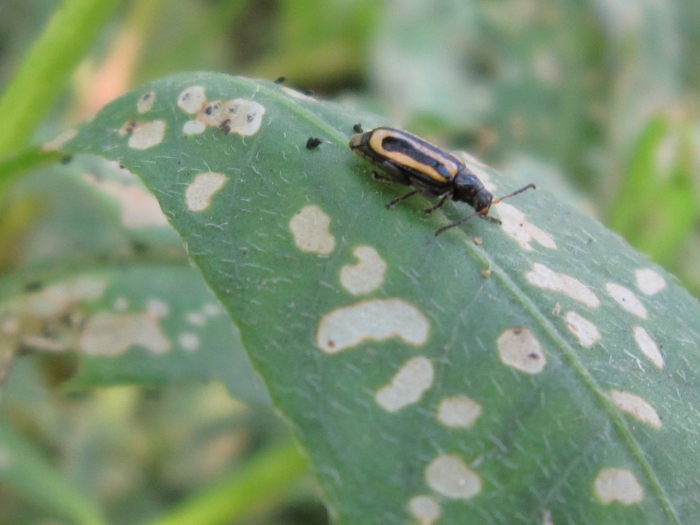The Editor’s Choice paper for the final issue of 2018 is titled Manipulating two olfactory cues causes a biological control beetle to shift to non-target plant species by Li et al. Professor Stephen Bonser, who handled the paper as an Associate Editor, gives some thoughts on the paper…
Phytophagous insects are potentially useful biocontrol agents. Insect specialisation on a single host species is an important condition of the use of insects in biocontrol. Host shifts to non-target species is undesirable in a biocontrol treatment.
Here in Australia, the unintended ecological impacts following the introduction of the cane toad as a biocontrol agent have been profound. More generally, we know that host shifts in specialised insect herbivores do occur, as host shifts drive the diversity of phytophagous insect taxa (e.g. Farrell, 1998). Surprisingly, we remain uncertain about how many biocontrol insects detect their host plants.
In this issue’s editors’ choice article, Li et al. perform an elegant series of studies demonstrating the olfactory mechanism of host plant selection of the flea beetle (Agasicles hygrophila) on the invasive host plant alligator weed (Alternathera philoxeroides). The authors examined volatile chemicals produced from alligator weed, and other non-host species, including closely related species and species with the same growth forms. They then examined how beetles responded to different combinations of volatile chemicals.

Adult flea beetle on the host plant aligator weed
Some volatile chemicals have important roles in the interactions between herbivores and plants. For example, a range of volatile chemicals are used by herbivores to detect appropriate host plants (Bruce et al. 2005). Jasmonates are commonly released by damaged plants, and these volatile chemicals have been demonstrated to be important in inducing plant defences (Kessler and Baldwin 2001). However, a single volatile chemical common across plant taxa offers little opportunity for specialist insects to detect a single host plant species. The ratio of numerous volatile chemicals is likely to be important in the location of host plants by insect herbivores (Bruce et al. 2005)
In their study, Li et al. used a series of field preference experiments, olfactory preference assays, and volatile addition preference trials to establish how A. hygrophila individuals locate their host plants. They extracted chemicals from each of 13 experimental plant species (including the host plant Alternathera philoxeroides) for their olfactory assays and volatile addition experiments. This approach allowed the authors to demonstrate how A. hygrophila beetles select host plants, and the conditions underlying host shifts to other species.

The larval flea beetle on the host plant
The authors found a strong preference for feeding and oviposition of female A. hygrophila beetles on their preferred host plant A. philoxeroides. Further, beetle larvae performed better on the host plant than on the closely related Alternathera sessilis plants. Host plant selection was due to a positive feeding and oviposition response to the volatile chemical (E)-4,8-dimethyl-1,3,7-nonatriene (DMNT) and a negative feeding and oviposition response to the volatile chemical (Z)-3-hexenol. The ratio of these two volatiles is a key factor in A. hygrophila locating their preferred hosts.
Importantly, these two chemicals are common across plant species. The ratio of DMNT and (Z)-3-hexenol in A. sessilis is similar to that of the preferred host A. philoxeroides, and beetles often selected this non-host species for feeding and oviposition. Indeed, A. hygrophila beetles have been observed in wild A. sessilis populations. Host shifts in specialist insect herbivores may be common in instances where biocontrol agents select hosts on the presence and/or absence of common volatile chemicals. Perhaps the reduced fitness of individuals on new hosts limits the success of these host-shifted populations. However, adapting to these new hosts does not seem to be an insurmountable challenge as rapid evolution to new environmental stresses is common across animal and plant taxa.
This study has important implications for the use of insects as biocontrol agents. Host detection by common volatiles (those that are likely to also occur in some non-target species), and rapid adaptation of insects on new hosts sets the stage for unwanted and potentially problematic hosts shifts. These are potentially fertile areas for future research.
Stephen Bonser, UNSW Australia, Journal of Ecology Associate Editor
Read the full paper here: Manipulating two olfactory cues causes a biological control beetle to shift to non-target plant species


